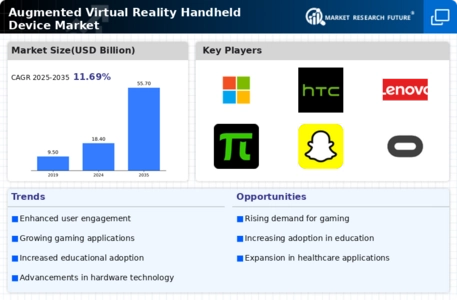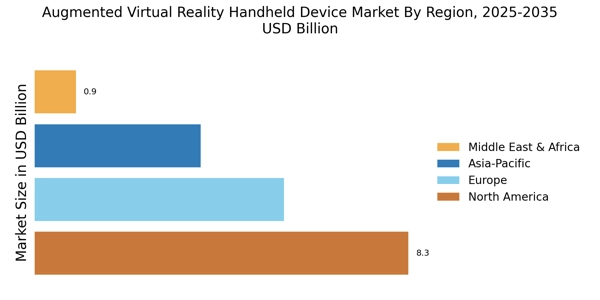Enhanced User Engagement
User engagement is a critical factor influencing the Augmented Virtual Reality Handheld Device Market. The ability of AR devices to create interactive and immersive experiences fosters deeper connections between users and content. This heightened engagement is particularly evident in sectors such as education and training, where AR applications facilitate experiential learning. For instance, studies have shown that students using AR tools demonstrate improved retention rates and understanding of complex subjects. Additionally, businesses are increasingly adopting AR for marketing purposes, as interactive advertisements have been shown to capture consumer attention more effectively than traditional methods. The potential for enhanced user engagement is likely to drive further investment in AR technologies, leading to a broader range of applications and increased market penetration.
Diverse Application Areas
The versatility of augmented reality technology is a significant driver for the Augmented Virtual Reality Handheld Device Market. AR applications span various sectors, including healthcare, retail, education, and entertainment, each presenting unique opportunities for growth. In healthcare, for example, AR devices are utilized for surgical simulations and patient education, enhancing the quality of care. In retail, AR applications allow customers to visualize products in their environment before making a purchase, thereby improving the shopping experience. The education sector benefits from AR by providing interactive learning tools that engage students in new ways. As industries continue to explore the potential of AR, the demand for handheld devices is expected to rise, reflecting the technology's adaptability and relevance across different fields.
Increased Consumer Demand
Consumer demand for immersive experiences is a key driver in the Augmented Virtual Reality Handheld Device Market. As individuals seek more engaging and interactive content, the appeal of augmented reality devices has surged. Market Research Future indicates that the demand for AR applications in gaming and entertainment has significantly increased, with a notable rise in the number of users engaging with AR content. This trend is further supported by the growing popularity of mobile gaming, which has seen a substantial increase in revenue, reaching billions annually. Furthermore, the rise of social media platforms that incorporate AR features has contributed to heightened consumer interest. As more users become accustomed to augmented experiences, the market for handheld devices is expected to expand, catering to a diverse range of applications from entertainment to practical uses in retail and marketing.
Technological Advancements
The Augmented Virtual Reality Handheld Device Market is experiencing rapid technological advancements that enhance user experience and functionality. Innovations in display technology, such as OLED and microLED, provide superior image quality and energy efficiency. Additionally, improvements in processing power, driven by advancements in mobile chipsets, enable more complex applications and smoother interactions. According to recent data, the market for augmented reality devices is projected to grow at a compound annual growth rate of over 30% in the next five years. This growth is largely attributed to the integration of artificial intelligence and machine learning, which allows for more intuitive user interfaces and personalized experiences. As these technologies continue to evolve, they are likely to drive further adoption of handheld devices in various sectors, including gaming, education, and healthcare.
Strategic Partnerships and Collaborations
Strategic partnerships and collaborations are emerging as a vital driver in the Augmented Virtual Reality Handheld Device Market. Companies are increasingly recognizing the value of joining forces to leverage complementary strengths and accelerate innovation. Collaborations between technology firms, content creators, and educational institutions are fostering the development of new applications and enhancing the overall ecosystem. For instance, partnerships between AR hardware manufacturers and software developers can lead to the creation of tailored solutions that meet specific market needs. Additionally, collaborations with academic institutions can facilitate research and development efforts, driving advancements in AR technology. As these partnerships continue to evolve, they are likely to contribute to the growth and diversification of the market, enabling the introduction of novel applications and enhancing user experiences.

















Leave a Comment